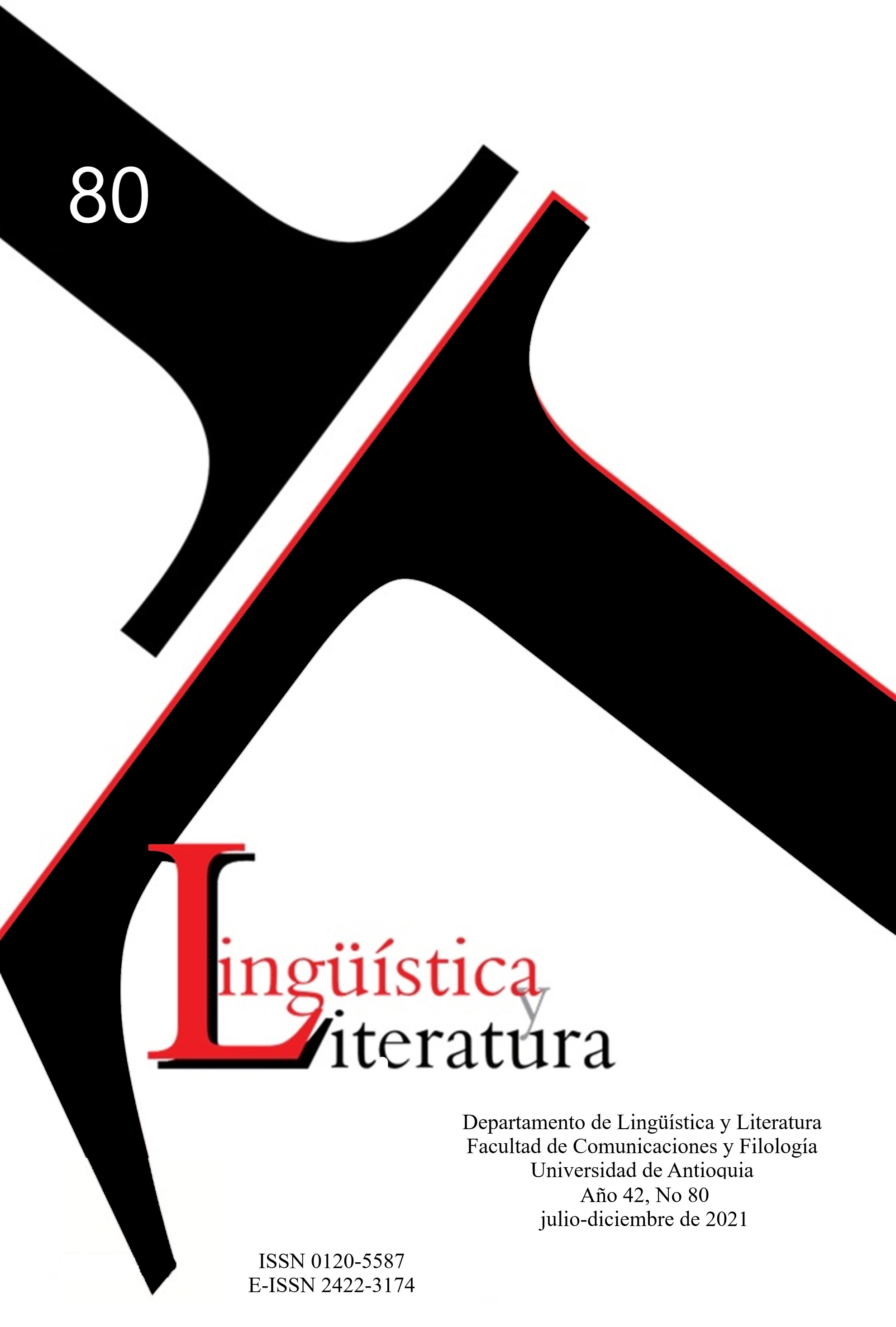Apollonian Art and Dionysian Art in O Caso Morel, by Rubem Fonseca
DOI:
https://doi.org/10.17533/udea.lyl.n80a06Keywords:
O caso Morel, Rubem Fonseca, Appolonian art, Dionysian artAbstract
This article analyzes the conception of art expressed by the characters in O caso Morel and its influence in the evolution of their behavior and the development of the novel’s plot, especially in the sexual aspect. Nietzschean differentiation between Apollonian and Dionysian art is used as a theoretical axis. In the novel a type of police is configured called «Dionysian Police», due to its affinity with the characteristics of such concept. The affinity these characters possess for Dionysian art leads them to have a transgressive life that imitates and is inspired by art.
Downloads
References
2. Cardozo, Ó. (2009). La estética de la violencia sexual en Sade y en El caso Morel de Rubem Fonseca [tesis de Pregrado, Pontificia Universidad Javeriana]. Repositorio Institucional Javeriana. http://hdl.handle.net/10554/6406
3. Comellas, P. (2014). Rubem Fonseca e o policial noir. Abriu. Estudos de Textualidade do Brasil, Galicia e Portugal, 3, 51-69. http://hdl.handle.net/2445/65111
4. Follain, V. (2009). Rubem Fonseca y la literatura urbana. Taller de Letras, 44, 103-114.
5. Fonseca, R. (2015). El caso Morel. Tajamar Editores.
6. Fonseca, R. (1987). Bufo & Spallanzani. (Losada, B. ed. y trad.). Epublibre.
7. Freud, S. (1992). Obras completas. Tomo XIV (Etcheverry, J. ed. y trad.). Amorrortu.
9. García, P. (2014). La novela neopolicial latinoamericana: una revuelta ético-estética del género. Cuadernos Americanos: Nueva Época, 2(148), 63-85.
10. Gonçalves, E. (2008). O paradoxo feminino em O caso Morel, de Rubem Fonseca. Revista Da Graduação, 2(1). https://revistaseletronicas.pucrs.br/ojs/index.php/graduacao/article/view/5009
11. González, M. (2003). Topógrafo de la sordidez: periodismo, pornografía y violencia en la obra de Rubem Fonseca. En Brú, J. (Comp.), Acercamientos a Rubem Fonseca. Premio Juan Rulfo. Universidad de Guadalajara, Centro Universitario de Ciencias Sociales y Humanidades.
12. Laplanche, J., Pontalis, J. y Lagache, D. (2004). Diccionario de psicoanálisis (Vol. 447). Paidós.
13. López, A. (2007). Violencia y literatura en «El cobrador» de Rubem Fonseca. En Las dos orillas: Actas del xv Congreso de la Asociación Internacional de Hispanistas. Monterrey, México, del 19 al 24 de julio de 2004 (pp. 393-404). Fondo de Cultura Económica.
14. Mendoza, E. (2003). El que a hierro mata, la va pasando: la narrativa de Rubem Fonseca. En Brú, J. (Comp.), Acercamientos a Rubem Fonseca. Premio Juan Rulfo. Universidad de Guadalajara, Centro Universitario de Ciencias Sociales y Humanidades.
15. Nietzsche, F. (2000). El nacimiento de la tragedia. Alianza Editorial.
16. Noguerol, F. (2006). Neopolicial latinoamericano: el triunfo del asesino. Ciberletras: Revista de Crítica Literaria y de Cultura, 15, 23-57.
17. Pimentel, L. (2003). Écfrasis y lecturas iconotextuales. Poligrafías. Revista de Literatura Comparada, 4, 205-215.
18. Rancière, J. (2011). El destino de las imágenes (M. Gajdowski, ed. y trad.). Prometeo Libros.
19. Rejany, M. (1999). O gênero feminino em Rubem Fonseca. Anuário de Literatura, 7(7), 169-189.
20. Ribeiro, J. (2001). O caso Morel: um caso de investigação literária. Signótica,13(1), 101-116. https://doi.org/10.5216/sig.v13i1.7294
21. Robillard, V. (2011). En busca de la ecfrasis (un acercamiento intertextual). En Artigas, I. y González, S. (Eds.), Entre artes, entre actos, ecfrasis e intermedialidad (pp. 28-50). Bonilla Artigas Editores, UNAM.
22. Rocha, R. (2012). O caso Morel: um caso metaficcional. Signótica, 24(1), 173-189. https://doi.org/10.5216/sig.v24i1.17923
23. Schrock, P. E. (1996). Man Ray’s Le Cadeau: The Unnatural Woman and the De-Sexing of Modern Man. Woman’s Art Journal.
24. Soláns, P. (2000). Accionismo vienés (Vol. 5). Editorial Nerea.
25. Taibo II, P. I. (1987). La «otra» novela policíaca. Los Cuadernos del Norte: Revista Cultural de la Caja de Ahorros de Asturias, 8(41), 36-41.
26. Tello, R. (1993). La violencia como estética de la misantropía: cuatro acercamientos a la obra de Rubem Fonseca [tesis de Maestría, Universidad Nacional Autónoma de México]. Repositorio Institucional UNAM. https://repositorio.unam.mx/contenidos/384262
27. Tello, R. (2004). La violencia como estética de la misantropía en la obra de Rubem Fonseca. En R. Tello (ed. y trad.), Los mejores relatos. Alfaguara.
28. Tornquist, H. (2007). O romance e a violência urbana. Outra Travessia, (6), 127-136.
Published
How to Cite
Issue
Section
License
Copyright (c) 2021 Lingüística y Literatura

This work is licensed under a Creative Commons Attribution-NonCommercial-ShareAlike 4.0 International License.
Creative Commons by-nc-sa
Those authors who have publications with this journal, accept the following terms:
1. The journal is the owner of the copyright of the articles, which will be simultaneously subject to the Creative Commons Attribution-NonCommercial-ShareAlike 4.0 International License. that allows third parties to share the work provided its author is indicated and its first publication in this journal.
2. The authors may adopt other agreements of non-exclusive license of distribution of the version of the published work (e.g., deposit it in an institutional telematic file or publish it in a monographic volume) provided that the initial publication in this journal is indicated.
3. Authors are allowed and recommended to disseminate their work via the Internet (e.g. in institutional telematic files or on their website) before and during the submission process, which can produce interesting exchanges and increase citations of the published work.










